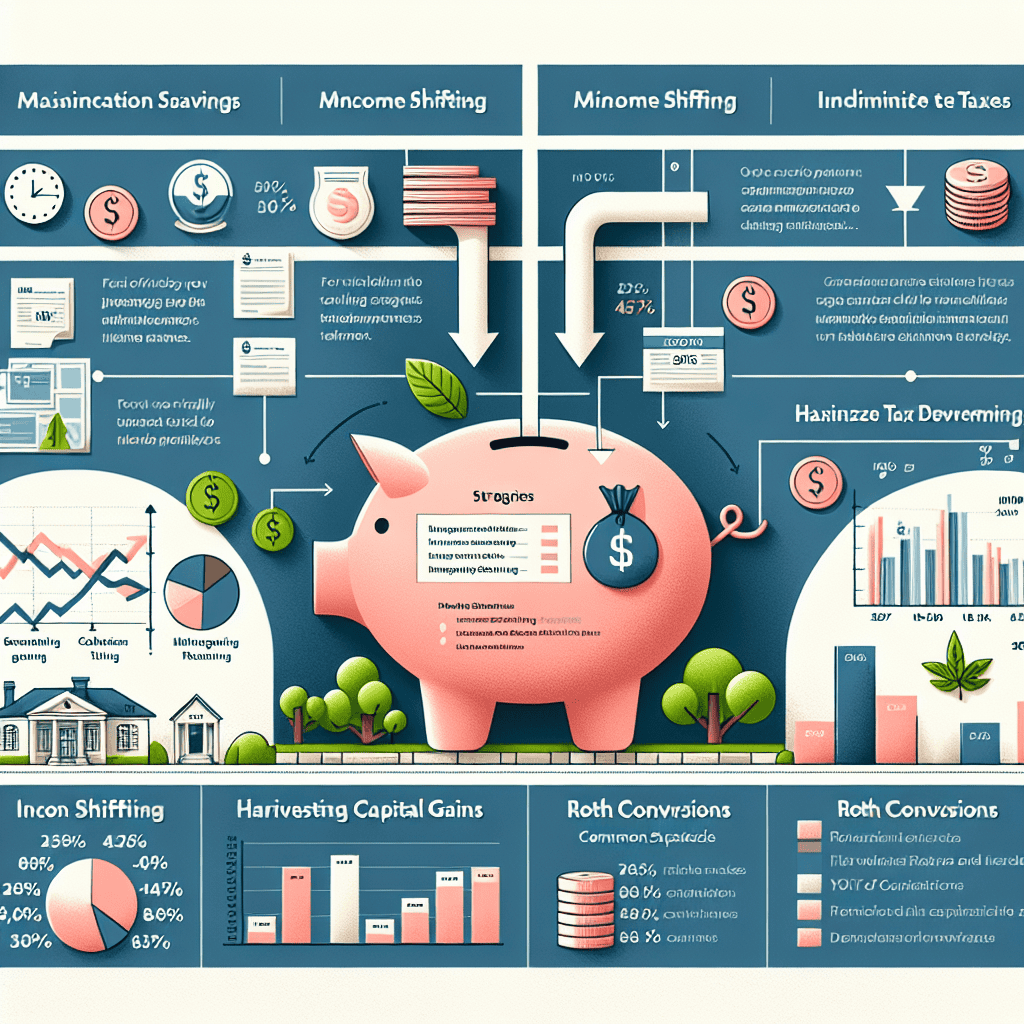“Unlock Your Golden Years: Smart Tax Strategies for a Wealthier Retirement”
Introduction
“Maximize Your Savings: Strategies to Minimize Taxes in Retirement” is a comprehensive guide designed to help retirees and those approaching retirement navigate the complex landscape of tax planning. As individuals transition from their working years to retirement, managing taxes becomes a crucial component of preserving wealth and ensuring financial stability. This guide explores a variety of strategies to effectively minimize tax liabilities, from optimizing retirement account withdrawals to leveraging tax-efficient investment vehicles. By understanding and implementing these strategies, retirees can enhance their savings, reduce unnecessary tax burdens, and enjoy a more secure and prosperous retirement.
Understanding Tax-Advantaged Accounts for Retirement Savings
As individuals approach retirement, the importance of understanding tax-advantaged accounts becomes increasingly evident. These accounts are designed to help retirees maximize their savings by minimizing the tax burden on their retirement income. By strategically utilizing these accounts, retirees can ensure a more financially secure future. To begin with, it is essential to comprehend the different types of tax-advantaged accounts available, such as Traditional IRAs, Roth IRAs, and 401(k) plans, each offering unique benefits and tax implications.
Traditional IRAs and 401(k) plans are popular choices for many individuals due to their immediate tax benefits. Contributions to these accounts are typically tax-deductible, which means they reduce taxable income in the year they are made. This feature is particularly advantageous for individuals in higher tax brackets, as it allows them to defer taxes until retirement when they may be in a lower tax bracket. However, it is crucial to remember that withdrawals from these accounts during retirement are subject to ordinary income tax. Therefore, careful planning is necessary to manage the tax impact of these distributions.
In contrast, Roth IRAs offer a different set of advantages. Contributions to Roth IRAs are made with after-tax dollars, meaning they do not provide an immediate tax deduction. However, the primary benefit of a Roth IRA lies in its tax-free growth and withdrawals. Once the account has been open for at least five years and the account holder reaches the age of 59½, all withdrawals, including earnings, are tax-free. This feature can be particularly beneficial for retirees who anticipate being in a higher tax bracket in the future or who wish to minimize their taxable income during retirement.
Moreover, understanding the rules surrounding required minimum distributions (RMDs) is vital for retirees utilizing tax-advantaged accounts. Traditional IRAs and 401(k) plans mandate that account holders begin taking RMDs at age 73, which can significantly impact taxable income. Failing to take the required distributions can result in substantial penalties. On the other hand, Roth IRAs do not have RMDs during the account holder’s lifetime, providing more flexibility in managing retirement income and taxes.
In addition to these individual accounts, Health Savings Accounts (HSAs) can also play a crucial role in retirement planning. While primarily designed to cover medical expenses, HSAs offer triple tax advantages: contributions are tax-deductible, growth is tax-free, and withdrawals for qualified medical expenses are also tax-free. For retirees, this means that HSAs can serve as a valuable tool for covering healthcare costs without incurring additional taxes, thereby preserving other retirement savings.
Furthermore, it is important to consider the impact of Social Security benefits on retirement taxes. Depending on total income, up to 85% of Social Security benefits may be taxable. By strategically withdrawing from tax-advantaged accounts, retirees can potentially reduce their taxable income and, consequently, the portion of Social Security benefits subject to taxation.
In conclusion, understanding and effectively utilizing tax-advantaged accounts is a critical component of retirement planning. By carefully considering the tax implications of each account type and strategically managing withdrawals, retirees can minimize their tax burden and maximize their savings. This approach not only enhances financial security but also provides peace of mind, allowing retirees to enjoy their golden years with confidence.
Strategies for Tax-Efficient Withdrawals in Retirement
As individuals transition into retirement, the focus often shifts from accumulating wealth to efficiently managing and preserving it. One of the most critical aspects of this financial management is minimizing taxes on retirement withdrawals. By employing strategic approaches to withdrawals, retirees can significantly enhance their savings and ensure a more secure financial future. Understanding the tax implications of different retirement accounts is the first step in developing a tax-efficient withdrawal strategy.
Retirement accounts such as traditional IRAs and 401(k)s are funded with pre-tax dollars, meaning that withdrawals are subject to ordinary income tax. Conversely, Roth IRAs are funded with after-tax dollars, allowing for tax-free withdrawals, provided certain conditions are met. Recognizing the tax characteristics of these accounts is essential for retirees aiming to minimize their tax burden. A common strategy is to withdraw from taxable accounts first, followed by tax-deferred accounts, and finally, tax-free accounts. This approach allows retirees to take advantage of lower tax rates on capital gains and dividends in taxable accounts while deferring taxes on traditional IRAs and 401(k)s for as long as possible.
Moreover, retirees should be mindful of the required minimum distributions (RMDs) that apply to traditional IRAs and 401(k)s starting at age 73. Failing to take RMDs can result in substantial penalties, so it is crucial to incorporate these mandatory withdrawals into the overall strategy. To mitigate the impact of RMDs, retirees might consider converting a portion of their traditional IRA or 401(k) to a Roth IRA. This conversion, while taxable, can reduce future RMDs and potentially lower the overall tax liability in retirement.
In addition to managing withdrawals from retirement accounts, retirees should also consider the timing of Social Security benefits. Delaying Social Security benefits until age 70 can result in a higher monthly benefit, which can be advantageous for those who expect to live longer. However, the decision to delay should be weighed against the need for immediate income and the potential tax implications. For instance, if delaying Social Security allows for larger withdrawals from tax-deferred accounts, it could push retirees into a higher tax bracket.
Furthermore, retirees can explore the benefits of tax-loss harvesting, a strategy that involves selling investments at a loss to offset capital gains. This approach can be particularly useful in years when the market is volatile, allowing retirees to reduce their taxable income. Additionally, retirees should be aware of the potential impact of state taxes on their retirement income. Some states do not tax Social Security benefits or offer exemptions for certain types of retirement income, which can influence the decision of where to live in retirement.
Finally, consulting with a financial advisor or tax professional can provide personalized guidance tailored to individual circumstances. These professionals can help retirees navigate the complexities of tax laws and develop a comprehensive withdrawal strategy that aligns with their financial goals. By proactively managing withdrawals and understanding the tax implications, retirees can maximize their savings and enjoy a more financially secure retirement. Through careful planning and strategic decision-making, it is possible to minimize taxes and preserve wealth for the years ahead.
The Role of Roth Conversions in Minimizing Taxes
As individuals approach retirement, the focus often shifts from accumulating wealth to preserving it, with a particular emphasis on minimizing taxes. One effective strategy that has gained popularity in recent years is the Roth conversion. This financial maneuver involves converting a traditional IRA or 401(k) into a Roth IRA, thereby potentially reducing the tax burden during retirement. Understanding the role of Roth conversions in minimizing taxes requires a comprehensive examination of their benefits, timing, and potential pitfalls.
To begin with, Roth conversions offer a significant advantage in terms of tax-free growth. Unlike traditional retirement accounts, where withdrawals are taxed as ordinary income, Roth IRAs allow for tax-free withdrawals, provided certain conditions are met. This feature can be particularly beneficial for retirees who anticipate being in a higher tax bracket in the future or who wish to avoid the uncertainty of future tax rate increases. By paying taxes on the converted amount now, retirees can secure a source of tax-free income later, thus potentially reducing their overall tax liability.
Moreover, Roth conversions can play a crucial role in managing required minimum distributions (RMDs). Traditional IRAs and 401(k)s mandate RMDs starting at age 73, which can significantly increase taxable income and potentially push retirees into higher tax brackets. In contrast, Roth IRAs do not require RMDs during the account holder’s lifetime, allowing for greater control over taxable income. By strategically converting traditional accounts to Roth IRAs, retirees can effectively manage their RMDs and maintain a lower tax profile.
However, the timing of Roth conversions is critical to maximizing their tax benefits. Ideally, conversions should be executed during years when the retiree’s taxable income is lower, such as early retirement years before Social Security benefits or pension income begin. This approach minimizes the tax impact of the conversion itself. Additionally, spreading conversions over several years can prevent large tax spikes and help maintain a more consistent tax rate. It is also important to consider the impact of conversions on other financial aspects, such as Medicare premiums, which can increase if income thresholds are exceeded.
Despite their advantages, Roth conversions are not without potential drawbacks. One significant consideration is the immediate tax liability incurred at the time of conversion. Retirees must be prepared to pay taxes on the converted amount, which can be substantial depending on the size of the account. It is generally advisable to use funds outside of the retirement account to cover this tax bill, preserving the converted amount for future growth. Additionally, Roth conversions may not be suitable for everyone, particularly those who expect to be in a lower tax bracket during retirement or who have a short investment horizon.
In conclusion, Roth conversions can be a powerful tool for minimizing taxes in retirement, offering benefits such as tax-free growth and greater control over taxable income. However, careful planning and consideration of individual circumstances are essential to fully realize these advantages. By understanding the nuances of Roth conversions and strategically implementing them as part of a broader retirement plan, retirees can effectively manage their tax liabilities and maximize their savings. As with any financial strategy, consulting with a tax professional or financial advisor is recommended to tailor the approach to specific needs and goals.
How to Leverage Tax Credits and Deductions in Retirement

As individuals transition into retirement, managing finances becomes a crucial aspect of ensuring a comfortable and sustainable lifestyle. One of the most effective ways to maximize savings during this period is by strategically minimizing taxes. Leveraging tax credits and deductions can significantly reduce the tax burden, allowing retirees to preserve more of their hard-earned money. Understanding how to effectively utilize these financial tools is essential for anyone looking to optimize their retirement savings.
To begin with, it is important to recognize the difference between tax credits and deductions. Tax credits directly reduce the amount of tax owed, offering a dollar-for-dollar reduction. In contrast, tax deductions lower the taxable income, which in turn reduces the overall tax liability. Both mechanisms can be beneficial, but they operate in distinct ways and can be applied to different aspects of a retiree’s financial situation.
One of the most advantageous tax credits available to retirees is the Retirement Savings Contributions Credit, commonly known as the Saver’s Credit. This credit is designed to encourage low- to moderate-income individuals to save for retirement by providing a credit for contributions made to retirement accounts such as IRAs and 401(k)s. Although the Saver’s Credit is more commonly associated with working individuals, retirees who continue to contribute to these accounts can still benefit, provided they meet the income requirements.
In addition to credits, retirees can also take advantage of various deductions to minimize their taxable income. Medical expenses, for instance, can be a significant deduction for retirees, especially as healthcare costs tend to increase with age. The Internal Revenue Service (IRS) allows taxpayers to deduct medical expenses that exceed a certain percentage of their adjusted gross income. By keeping meticulous records of medical expenses, retirees can ensure they are maximizing this deduction.
Another valuable deduction for retirees is related to charitable contributions. Many retirees choose to engage in philanthropy, and the IRS provides deductions for donations made to qualified charitable organizations. This not only supports meaningful causes but also offers a way to reduce taxable income. Retirees should ensure they maintain proper documentation of their contributions to take full advantage of this deduction.
Furthermore, retirees should consider the tax implications of their investment income. Capital gains and dividends are subject to different tax rates, and understanding these can help in planning withdrawals from investment accounts. For instance, long-term capital gains are typically taxed at a lower rate than ordinary income, which can be beneficial for retirees who strategically manage their investment portfolios.
Additionally, retirees should be aware of the potential benefits of state-specific tax credits and deductions. Some states offer unique tax advantages for retirees, such as exemptions on certain types of retirement income or property tax relief programs. Exploring these options can provide further opportunities to reduce the overall tax burden.
In conclusion, effectively leveraging tax credits and deductions is a vital strategy for minimizing taxes in retirement. By understanding the various credits and deductions available, retirees can make informed decisions that enhance their financial well-being. Whether through contributions to retirement accounts, deductions for medical expenses and charitable contributions, or strategic management of investment income, there are numerous ways to optimize tax savings. As retirees navigate this new phase of life, a proactive approach to tax planning can ensure a more secure and prosperous retirement.
Timing Social Security Benefits for Optimal Tax Savings
When planning for retirement, one of the most crucial considerations is how to effectively manage and minimize taxes, particularly when it comes to Social Security benefits. Understanding the timing of these benefits can significantly impact your overall tax burden, thereby maximizing your savings. As you approach retirement, it is essential to evaluate the optimal time to begin receiving Social Security benefits, as this decision can have long-lasting financial implications.
To begin with, it is important to recognize that the age at which you start receiving Social Security benefits can affect the amount you receive monthly. While you are eligible to start benefits at age 62, delaying until your full retirement age, which varies depending on your birth year, can result in a higher monthly benefit. Moreover, if you postpone benefits until age 70, you can receive an even larger amount due to delayed retirement credits. This increase in benefits can be advantageous, but it is crucial to weigh this against the potential tax implications.
In terms of taxation, Social Security benefits can be subject to federal income tax depending on your combined income, which includes adjusted gross income, nontaxable interest, and half of your Social Security benefits. If your combined income exceeds certain thresholds, up to 85% of your benefits may be taxable. Therefore, strategically timing when to start receiving benefits can help manage your taxable income and potentially reduce the amount of tax owed.
One strategy to consider is coordinating Social Security benefits with other sources of retirement income. For instance, if you have significant retirement savings in tax-deferred accounts such as a 401(k) or traditional IRA, it may be beneficial to withdraw from these accounts before starting Social Security. This approach can help lower your taxable income in the early years of retirement, potentially reducing the portion of your Social Security benefits that are subject to tax. Additionally, by drawing down tax-deferred accounts first, you may also reduce the size of required minimum distributions (RMDs) later in retirement, further managing your tax liability.
Another consideration is the impact of state taxes on Social Security benefits. While the majority of states do not tax Social Security benefits, some do. Understanding your state’s tax policies can inform your decision on when to start benefits and how to structure your overall retirement income strategy. Consulting with a tax advisor or financial planner can provide personalized guidance based on your specific circumstances and help you navigate the complexities of state and federal tax laws.
Furthermore, it is essential to consider the potential impact of future tax policy changes. While current laws provide a framework for planning, tax policies can evolve, affecting the taxation of Social Security benefits. Staying informed about potential legislative changes and adjusting your strategy accordingly can help ensure that you continue to minimize taxes throughout retirement.
In conclusion, timing your Social Security benefits is a critical component of an effective tax minimization strategy in retirement. By carefully considering when to start benefits, coordinating with other income sources, and staying informed about tax policies, you can optimize your retirement income and maximize your savings. Thoughtful planning and professional guidance can help you navigate these decisions, ultimately leading to a more financially secure retirement.
Managing Required Minimum Distributions to Reduce Tax Burden
As individuals transition into retirement, managing finances becomes a crucial aspect of ensuring a comfortable and sustainable lifestyle. One of the key financial considerations during this phase is the management of Required Minimum Distributions (RMDs) from retirement accounts, which can significantly impact one’s tax burden. Understanding how to effectively manage RMDs can lead to substantial tax savings, thereby maximizing the funds available for other retirement needs.
To begin with, it is essential to comprehend what RMDs entail. Once an individual reaches the age of 72, the Internal Revenue Service (IRS) mandates that they begin withdrawing a minimum amount annually from their tax-deferred retirement accounts, such as traditional IRAs and 401(k)s. These withdrawals are subject to ordinary income tax, and failing to take the required amount can result in hefty penalties. Therefore, strategic planning around RMDs is vital to minimize the tax implications.
One effective strategy to manage RMDs is to consider the timing of withdrawals. By carefully planning when to take distributions, retirees can potentially reduce their taxable income in a given year. For instance, if an individual anticipates a lower income year, it might be advantageous to take a larger distribution during that period to take advantage of a lower tax bracket. Conversely, spreading out distributions over several years can help avoid pushing oneself into a higher tax bracket.
Another approach to managing RMDs is through charitable contributions. The IRS allows individuals aged 70½ and older to make Qualified Charitable Distributions (QCDs) directly from their IRAs to a qualified charity. These distributions can count towards satisfying the RMD requirement while excluding the amount from taxable income. This strategy not only fulfills philanthropic goals but also provides a tax-efficient way to manage RMDs.
Moreover, converting traditional IRAs to Roth IRAs can be a beneficial long-term strategy. While Roth conversions are taxable events, they can lead to tax-free withdrawals in the future, as Roth IRAs do not have RMDs during the account holder’s lifetime. By converting during years of lower income or when tax rates are favorable, retirees can potentially reduce the tax impact of future RMDs. However, it is crucial to carefully evaluate the tax implications of conversions and consult with a financial advisor to ensure this strategy aligns with one’s overall financial plan.
Additionally, retirees should consider the impact of RMDs on other aspects of their financial situation, such as Social Security benefits and Medicare premiums. Since RMDs increase taxable income, they can affect the taxation of Social Security benefits and potentially lead to higher Medicare premiums. By strategically managing RMDs, retirees can mitigate these effects and preserve more of their retirement income.
In conclusion, managing Required Minimum Distributions is a critical component of minimizing taxes in retirement. Through careful planning and strategic implementation of various techniques, retirees can effectively reduce their tax burden and maximize their savings. Whether through timing withdrawals, utilizing charitable contributions, considering Roth conversions, or understanding the broader financial implications, there are numerous strategies available to manage RMDs efficiently. By taking a proactive approach and seeking professional guidance, retirees can navigate the complexities of RMDs and enjoy a more financially secure retirement.
Estate Planning Techniques to Minimize Taxes for Heirs
In the realm of estate planning, minimizing taxes for heirs is a crucial consideration for many individuals seeking to preserve their wealth for future generations. As retirement approaches, it becomes increasingly important to implement strategies that not only secure one’s financial future but also ensure that heirs receive the maximum possible benefit from the estate. By understanding and utilizing various estate planning techniques, retirees can effectively minimize the tax burden on their heirs, thereby maximizing the value of the inheritance.
One of the most effective strategies for minimizing taxes on an estate is the use of trusts. Trusts can be tailored to meet specific goals, such as reducing estate taxes, protecting assets from creditors, or providing for beneficiaries in a controlled manner. For instance, a revocable living trust allows individuals to maintain control over their assets during their lifetime while ensuring a smooth transfer to heirs upon their passing. This type of trust can help avoid the probate process, which can be both time-consuming and costly, thereby preserving more of the estate’s value for heirs.
In addition to trusts, gifting strategies can play a significant role in reducing the taxable estate. By taking advantage of the annual gift tax exclusion, individuals can transfer a certain amount of money or assets to their heirs each year without incurring gift taxes. This not only reduces the size of the taxable estate but also allows for the gradual transfer of wealth to beneficiaries. Moreover, utilizing the lifetime gift tax exemption can further decrease the estate’s value, potentially lowering estate taxes upon death.
Another important consideration in estate planning is the strategic use of beneficiary designations. Retirement accounts, such as IRAs and 401(k)s, allow for the designation of beneficiaries, which can facilitate the direct transfer of assets upon the account holder’s death. By carefully selecting beneficiaries and understanding the tax implications of these designations, individuals can help ensure that their heirs receive the maximum benefit from these accounts. For example, naming a spouse as the primary beneficiary can allow for a tax-free rollover of the account, while designating a trust as the beneficiary can provide more control over the distribution of assets to heirs.
Furthermore, charitable giving can serve as a powerful tool in minimizing estate taxes. By including charitable donations in an estate plan, individuals can reduce the size of their taxable estate while supporting causes they care about. Charitable remainder trusts, for instance, allow individuals to receive income from their assets during their lifetime, with the remainder going to a designated charity upon their death. This not only provides a potential income stream but also offers significant tax benefits, as the value of the donated assets is removed from the taxable estate.
In conclusion, effective estate planning requires a comprehensive understanding of the various strategies available to minimize taxes for heirs. By utilizing trusts, gifting strategies, beneficiary designations, and charitable giving, individuals can significantly reduce the tax burden on their estate, thereby maximizing the inheritance received by their heirs. As retirement approaches, it is essential to consult with financial and legal professionals to develop a tailored estate plan that aligns with one’s goals and ensures the preservation of wealth for future generations. Through careful planning and strategic implementation, retirees can achieve peace of mind knowing that their legacy will be protected and their heirs will benefit from their foresight and diligence.
Q&A
1. **What is tax-efficient withdrawal strategy?**
A tax-efficient withdrawal strategy involves taking distributions from retirement accounts in a way that minimizes tax liability, often by withdrawing from taxable accounts first, then tax-deferred accounts, and finally tax-free accounts like Roth IRAs.
2. **How can Roth conversions help in retirement tax planning?**
Roth conversions involve transferring funds from a traditional IRA to a Roth IRA, paying taxes on the converted amount now to potentially enjoy tax-free withdrawals later, which can be beneficial if you expect to be in a higher tax bracket in the future.
3. **What role do Required Minimum Distributions (RMDs) play in retirement tax planning?**
RMDs are mandatory withdrawals from tax-deferred retirement accounts starting at age 72, which can increase taxable income. Planning for RMDs can help manage tax brackets and avoid large tax bills.
4. **How can charitable contributions reduce taxes in retirement?**
Qualified Charitable Distributions (QCDs) allow individuals aged 70½ or older to donate up to $100,000 directly from an IRA to a charity, which can satisfy RMD requirements and reduce taxable income.
5. **What is the impact of Social Security benefits on taxes in retirement?**
Up to 85% of Social Security benefits may be taxable depending on your combined income. Strategically managing other income sources can help minimize the tax impact on Social Security benefits.
6. **How can tax diversification benefit retirees?**
Tax diversification involves holding assets in accounts with different tax treatments (taxable, tax-deferred, and tax-free), providing flexibility to manage taxable income and withdrawals efficiently in retirement.
7. **What is the benefit of delaying Social Security benefits?**
Delaying Social Security benefits past full retirement age can increase the monthly benefit amount by up to 8% per year until age 70, potentially resulting in higher lifetime benefits and a more favorable tax situation.
Conclusion
In conclusion, effectively minimizing taxes in retirement requires strategic planning and a comprehensive understanding of available tax-saving opportunities. By utilizing tax-advantaged accounts, such as Roth IRAs and 401(k)s, retirees can manage their taxable income and potentially reduce their tax burden. Additionally, strategically timing withdrawals, considering the tax implications of Social Security benefits, and exploring tax-efficient investment strategies can further enhance savings. Consulting with a financial advisor or tax professional can provide personalized guidance to optimize these strategies, ensuring a more financially secure and tax-efficient retirement.





